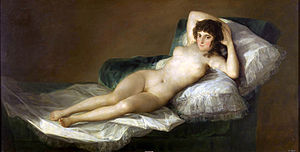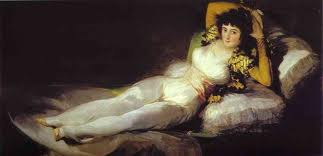Maja Desnuda, Maja Vestida (Naked Maja, Clothed Maja): Difference between revisions
NCACintern (talk | contribs) No edit summary |
NCACintern (talk | contribs) No edit summary |
||
| Line 48: | Line 48: | ||
====Region: [[:Category:North America|North America]]==== | ====Region: [[:Category:North America|North America]]==== | ||
====Subject: [[:Category:Political/Economic/Social Opinion|Political/Economic/Social Opinion]] [[:Category:Explicit Sexuality|Explicit Sexuality | ====Subject: [[:Category:Political/Economic/Social Opinion|Political/Economic/Social Opinion]] [[:Category:Explicit Sexuality|Explicit Sexuality]]==== | ||
====Medium: [[:Category:Painting|Painting]]==== | ====Medium: [[:Category:Painting|Painting]]==== | ||
| Line 60: | Line 60: | ||
'''Location:''' Philadelphia, Pennsylvania, USA | '''Location:''' Philadelphia, Pennsylvania, USA | ||
'''Description of Artwork:''' Two of Goya's pieces which are known to have aroused the anger of the censors of the Inquisition are ''Maja Desnuda'' (1800, Naked Maja) and ''Maja Vestida'' (1808, Clothed Maja). These were unusual pieces for Goya which presented a woman lying on a bed, and, in the case of ''Maja Desnuda'', a naked woman lying on a bed. Especially scandalizing to the Inquisitors was the naked Maja's visible pubic hair. Anther piece which may have been censored and angered the royal court was ''Los Caprichos'' (1799, The Caprices), which was a satirical, unflattering portrait of the family of Charles IV. <P> | '''Description of Artwork:''' Two of Goya's pieces which are known to have aroused the anger of the censors of the Inquisition are ''Maja Desnuda'' (1800, Naked Maja) and ''Maja Vestida'' (1808, Clothed Maja). These were unusual pieces for Goya which presented a woman lying on a bed, and, in the case of ''Maja Desnuda'', a naked woman lying on a bed. Especially scandalizing to the Inquisitors was the naked Maja's visible pubic hair. Anther piece which may have been censored and angered the royal court was ''Los Caprichos'' (1799, The Caprices), which was a satirical, unflattering portrait of the family of Charles IV. <P> | ||
'''The Incident:''' On November 7, 1991, a memo circulated at Pennsylvania State University Commonwealth Campus announcing the affirmative action office had been notified “that one of the art reproductions . . . hanging in [Room] C-203 could contribute to a chilly climate in that classroom, and, thus, be in violation of the law concerning sexual harassment.” As the memo claimed, “The reason given is that the reproduction in question, although a recognized art work [sic], is being displayed in a classroom rather than in a gallery or museum setting . . . Therefore, because we have no defined gallery space for art displays, all reproductions will be removed from C-203 and placed in storage.” <P> | '''The Incident:''' On November 7, 1991, a memo circulated at Pennsylvania State University Commonwealth Campus announcing the affirmative action office had been notified “that one of the art reproductions . . . hanging in [Room] C-203 could contribute to a chilly climate in that classroom, and, thus, be in violation of the law concerning sexual harassment.” As the memo claimed, “The reason given is that the reproduction in question, although a recognized art work [sic], is being displayed in a classroom rather than in a gallery or museum setting . . . Therefore, because we have no defined gallery space for art displays, all reproductions will be removed from C-203 and placed in storage.” <P> | ||
Revision as of 15:48, 11 July 2023
Date: 1815
Region: Europe
Subject: Political/Economic/Social Opinion Explicit Sexuality
Medium: Painting
Artist: Francisco Goya (1746 - 1828)
Confronting Bodies: The Spanish Inquisition, King Charles IV
Date of Action: 1815
Location: Spain
Description of Artwork: Two of Goya's pieces which are known to have aroused the anger of the censors of the Inquisition are Maja Desnuda (1800, Naked Maja) and Maja Vestida (1808, Clothed Maja). These were unusual pieces for Goya which presented a woman lying on a bed, and, in the case of Maja Desnuda, a naked woman lying on a bed. Especially scandalizing to the Inquisitors was the naked Maja's visible pubic hair. Anther piece which may have been censored and angered the royal court was Los Caprichos (1799, The Caprices), which was a satirical, unflattering portrait of the family of Charles IV.
The Incident: Maja Desnuda and Maja Vestida were both held in the "private cabinet" of the disgraced former chief minister of Spain, Manuel de Godoy. Godoy was hated in Spain for both his decadence and his part in Spain's collapse during the Napoleonic wars, which led to the abolition of the Inquisition by the French monarch, Joseph Bonaparte. When Bonaparte was deposed and the Inquisition was reinstated the Inquisitors were only too happy to bring to light Godoy's seedy habits, including the two paintings by Goya. The paintings were also considered especially scandalous because in the prudish, religious Spanish culture the nude was hardly ever portrayed in art. There had also been a recent surge in the popularity of pornography which the Inquisition was alarmed about. Goya was summoned to appear before the Inquisition to explain the works. The Inquisition, however, was not as powerful as it had been before the Napoleonic Wars, and it seems that Goya might have chosen to not appear before the Inquisition because there is no further mention of him in the Inquisition records. In 1825 Goya received a request for a copy of his satirical court portrait Los Caprichos. In Goya's reply he wrote "...they nevertheless accused me before the Inquisition, not would I copy them myself..." The glancing reference to censorship is taken by some to mean the work was censored, although it is more commonly accepted that Goya was referring to the censorship of the Maja paintings, which may have made him less popular with the royal court.
Results of Incident: The Majas paintings were taken to the Royal Academy sometime after the Inquisition was abolished and its assets distributed in 1835. The Clothed Maja was kept in another "private cabinet" for a number of years and The Nude Maja was not available for viewing until a Goya exhibit in 1900. In 1901 both paintings were acquired by the Prado.
Source: Censorship: A World Encyclopedia
Date: 1991
Region: North America
Subject: Political/Economic/Social Opinion Explicit Sexuality
Medium: Painting
Artist: Francisco Goya (1746 - 1828)
Confronting Bodies: Pennsylvania State University Commonwealth Campus, affirmative action office
Date of Action: 1991
Location: Philadelphia, Pennsylvania, USA
Description of Artwork: Two of Goya's pieces which are known to have aroused the anger of the censors of the Inquisition are Maja Desnuda (1800, Naked Maja) and Maja Vestida (1808, Clothed Maja). These were unusual pieces for Goya which presented a woman lying on a bed, and, in the case of Maja Desnuda, a naked woman lying on a bed. Especially scandalizing to the Inquisitors was the naked Maja's visible pubic hair. Anther piece which may have been censored and angered the royal court was Los Caprichos (1799, The Caprices), which was a satirical, unflattering portrait of the family of Charles IV.
The Incident: On November 7, 1991, a memo circulated at Pennsylvania State University Commonwealth Campus announcing the affirmative action office had been notified “that one of the art reproductions . . . hanging in [Room] C-203 could contribute to a chilly climate in that classroom, and, thus, be in violation of the law concerning sexual harassment.” As the memo claimed, “The reason given is that the reproduction in question, although a recognized art work [sic], is being displayed in a classroom rather than in a gallery or museum setting . . . Therefore, because we have no defined gallery space for art displays, all reproductions will be removed from C-203 and placed in storage.”
This wasn’t the first time Goya’s “Maja desnuda” was targeted at Pennsylvania State University Commonwealth Campus. Until the fall of 1991, the room had primarily been used as a music classroom, and instructor Paul Miller had refused requests from campus administrators to remove the work, citing censorship as his chief concern. The print of Goya's "Maja desnuda" was originally purchased over a decade earlier for an art history course taught in the same classroom.
Results of Incident: When the censors at Pennsylvania State University Commonwealth Campus finally won out over Goya’s “Maja desnuda,” administrators took down the rest of the art in the classroom along with it. As with Godoy’s gabinete, the other paintings hanging alongside Goya’s “Maja desnuda” also contained themes that made censors uncomfortable, and the paintings were deemed guilty by association. The “Maja desnuda” scandal not only led to the censorship of Goya’s image, but also the removal of Raphael’s "Madonna of the Chair," Bronzino’s "Portrait of a Young Man," the central panel of "Crucifixion with Virgin and Saints" by Perugino, and a van Ruisdael landscape, "Wheatfields."
Source:
• https://www.thefire.org/news/comeback-catechism-when-todays-speech-norms-launch-old-inquisitions,
• https://www.worldcat.org/title/944438388,
• https://www.jstor.org/stable/j.ctt169zt6h?turn_away=true,
• https://www.jstor.org/stable/3333360

